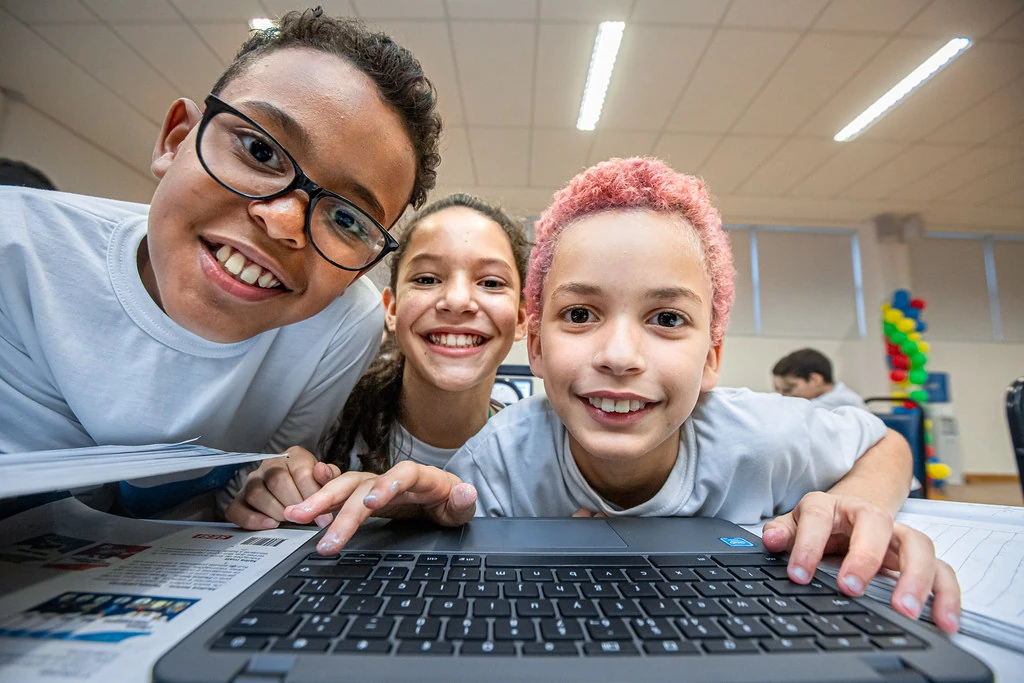Google Classroom, Meet, and Chrome introduce integrations and new functionalities, providing innovative features for educators.
Google is back at it again, showing its unwavering dedication to education. They’ve just unveiled a bunch of new tools and updates in Google Workspace for Education. Recently, at the renowned ISTE event, which happens to be the biggest educational technology exhibition in the United States, Google for Education wowed everyone with their innovative offerings. They’ve even incorporated Artificial Intelligence (AI) into some of these new features that promise to take teaching and learning experiences to a whole new level, making them more engaging and effective for both educators and students.


Find more info at:
Google is back at it again, showing its unwavering dedication to education. They’ve just unveiled a bunch of new tools and updates in Google Workspace for Education. Recently, at the renowned ISTE event, which happens to be the biggest educational technology exhibition in the United States, Google for Education wowed everyone with their innovative offerings. They’ve even incorporated Artificial Intelligence (AI) into some of these new features that promise to take teaching and learning experiences to a whole new level, making them more engaging and effective for both educators and students.
Top 5 New Features in Google Classroom
Google Classroom, the innovative platform for educators, continues to evolve with exciting new features, integrations, and AI support. Let’s take a look at the top five features that make Google Classroom even more powerful:1. Read Along Integration
Google Classroom now integrates Read Along, a fantastic reading learning service for children. This integration opens up a world of possibilities for educators, allowing them to support differentiated learning and track students’ progress through engaging reading activities. Currently in the early access program and available in English, you can express your interest in this tool by clicking here.2. AI-Supported Assignments
An exciting addition to Google Classroom is the power of AI in various functionalities. The Practice Sets feature, used by teachers to create interactive assignments with relevant web resources, now allows educators to not only add their own resources but also receive AI-generated suggestions. Furthermore, educators can now add interactive questions supported by AI when incorporating YouTube videos into assignments. This feature enables students to assess their understanding while watching the videos. Teachers have the flexibility to create their own questions or modify the AI-generated ones. Currently in Beta, this functionality provides language support for English, Spanish, Portuguese, Japanese, and Malay. If you’re interested in trying it out, click here.3. Classroom Analytics
Coming soon, Classroom Analytics is a highly anticipated feature that will be globally available in the coming months. This addition aims to empower education leaders in providing better support to educators and students. Classroom Analytics provides data on assignment completion rates, grade trends, and overall Google Classroom usage. Educators will also have access to similar information for their own classes, allowing them to effectively monitor student progress.4. Collaborative Lesson Planning
Google is committed to making Classroom a more collaborative platform, providing new ways for education leaders to support teachers and students. Soon, curriculum leaders and verified teachers will have the ability to simplify lesson planning by sharing links to class templates and classwork. This feature allows them to share up-to-date content and instructional design ideas, which can be seamlessly imported into their own classes without needing to be a co-teacher. Express your interest in the beta version of this feature by clicking here. The beta version is available in multiple languages, including English, Spanish, Portuguese, and Japanese.5. Premium Editions Upgraded
Educators utilizing the Teaching and Learning Upgrade and Education Plus editions will now enjoy enhanced capabilities in planning, organizing, and analyzing assignments and grades based on their preferred grading periods, such as quarters, semesters, or terms. They can also align grading scales with their region’s grading system, whether it employs letter grades, numeric values, or a custom scale. Additionally, highly requested features, including the ability to disable submissions after the due date and enhance comment functionality, will be available across all editions of Google Classroom.
Beyond Google Classroom: Expanding Educational Support
Google’s commitment to supporting education goes beyond Google Classroom, as the company continuously enhances its suite of products to provide valuable features for online education and promote inclusivity.Enhanced Interactions in Google Meet
Google Meet introduces new features that enhance online interactions. The tile pairing functionality now allows simultaneous highlighting of two individuals. This feature is particularly beneficial for scenarios such as pairing a presenter with their sign language interpreter. In addition, Q&A and polling capabilities are being introduced to livestreams, enabling educators to engage more effectively with larger audiences. Furthermore, Education Plus users will now have the ability to connect with up to 1,000 attendees in a single Meet session, facilitating broader communication.AI-powered Improvements to Chrome Browser
Google leverages the power of AI to bring accessible built-in features to the Chrome browser. In March, they announced a reading mode for Chrome on ChromeOS devices, allowing students to read text more easily by adjusting its size, font, and removing distractions. Now, this feature is being extended to all computers. Furthermore, the introduction of PDF OCR technology enables screen reader users to convert images to text within PDFs, making them accessible for reading and comprehension in Chrome Browser on ChromeOS. All of these new features in Chrome will be available in the coming months, empowering students and educators with diverse learning needs.
Promoting Safe Environments in Online Education
As online learning gains popularity, it becomes crucial to address potential risks and prioritize the safety of both students and educators. Creating safe environments in online education is paramount for several key reasons, including:-
- Protecting students from online predators.
- Preventing cyberbullying.
- Safeguard student’s and educators’ privacy.
- Protecting against malware and online threats.

What Can We Learn About the Intersection of Technology and Education?
Google’s recent advancements in educational tools and their utilization of artificial intelligence (AI) highlight the transformative potential of technology in teaching and learning, addressing the evolving needs of education in the modern world. However, as educators navigate the diverse landscape of technological innovations and cater to their students’ unique requirements, adopting or developing educational technology comes with valuable lessons. At Perspektiva 360, as software developers, we recommend keeping these 6 in mind.Lesson 1: Embrace Digital Literacy
In an era of technology-driven tools, digital literacy is crucial for both educators and students. Understanding basic technical functions and concepts greatly facilitates the adoption of technology in education. Developers must prioritize bridging the gap between technology and education, ensuring their tools are accessible and user-friendly.Lesson 2: Seize the Opportunity of AI
AI-supported features empower personalized learning, fostering students’ autonomy in skill development and addressing global challenges in areas such as reading. While managing large student groups presents a new challenge for educators, AI opens significant opportunities to leverage technology for education and reshape the role of teachers.Lesson 3: Foster Collaboration
Recognizing the importance of collaboration and socialization, education leaders and teachers should leverage technology to facilitate meaningful connections among individuals. Effective features that enhance online interactions and collaborations promote inclusivity and counteract tendencies toward individualism or isolation.Lesson 4: Adaptability is Essential
Technology for education should consider cultural contexts and regional needs. Education is culturally embedded and not standardized globally, so universally assumed functionalities may not always be suitable for specific regions. Google’s customizable features, sharing and collaboration capabilities, and grading enhancements exemplify how software can be adapted to diverse educational systems worldwide.Lesson 5: Strive for Inclusivity
Technology can address the challenges of inclusivity by providing equal access to information, training, and education for individuals with diverse needs. Google’s focus on inclusivity within educational contexts demonstrates the role technology plays in promoting equal opportunities and empowering all learners.Lesson 6: Prioritize Security
As a significant portion of our lives now exists in virtual spaces, protecting digital environments becomes integral to our overall well-being. Technology’s increasing complexity also amplifies potential risks to student and educator privacy. Developing features to control and protect privacy is crucial to ensure a secure and comfortable learning environment. Effective management of online predators, cyberbullying, malware, and other threats is essential. In conclusion, creating inclusive, collaborative, and secure educational environments through technology is achievable. By leveraging AI responsibly, promoting technology literacy, and prioritizing safety, developers, education leaders, and educators can shape the future of education, empowering new generations of students.Find more info at:
- New Google for Education tools for how you teach, learn and manage, blog by Google.
- Explore our new Google for Education App Hub, blog by Google.
- “Primeira Aula com os Chrome Books, Escola do Futuro” photographs by Prefeitura de Itapevi are licensed under CC BY 2.0.
- “Virtual Learning Illustration – VR in Education” by Digits.co.uk is licensed under CC BY 2.0.








